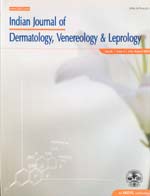
|
Indian Journal of Dermatology, Venereology and Leprology
Medknow Publications on behalf of The Indian Association of Dermatologists, Venereologists and Leprologists (IADVL)
ISSN: 0378-6323 EISSN: 0973-3922
Vol. 74, Num. 6, 2008, pp. 669-670
|
Indian Journal of Dermatology, Venereology and Leprology, Vol. 74, No. 6, November-December, 2008, pp. 669-670
Letter To Editor
Precision or Message: An editor's dilemma
Khopkar Uday
India
Correspondence Address:India
Code Number: dv08275
I welcome the critical analysis of titles of articles published in IJDVL by Dr. Singh and colleagues and appreciate their effort. I take it as a good sign for academics in the Indian dermatology community that they are developing a critical eye. However, the methodology of the analysis should have been more controlled and could have been blinded to avoid bias. Also, comparison with other journal articles could have helped to check as to where we stand.
Titles of several articles get altered during the process of reviewing and editing. This is usually done with the intent of making the article title not only clear and correct but also to evoke interest in the reader about the article. This is because a reader first looks at the title of an article and then decides whether to read the abstract or not and if the abstract is interesting then decides if he/she should read the full text.
In my estimation, the original articles are the least read and this is not because the majority of readers are not interested in studies, but because they find the language of science a barrier. It is with this intent that, since the last two years, we have been preparing a short summary cum comment on original articles and printing it within the table of contents itself.
It is heartening for me to note that the most frequent error found in our titles was that of minimization. I must admit that this was purposeful with the intent of making the titles more reader friendly. Majority of readers are more interested in the message from the article rather than the study design. While the study design is extremely important to the expert reader with special interest in the subject, it can always be mentioned in the abstract. The old recommendation of mentioning the study design and study subjects in titles was based on the need of old search engines to look for appropriate articles for researchers. Today′s search engines can find words not just in titles and abstracts but anywhere within the full text. In such a scenario even mentioning key words for articles is fast becoming redundant.
Finally, in this study, the error definitions used by the authors are made by the authors themselves and have not been subjected to any form of validation. Even authors agree that there are no guidelines made by the International Council of Medical Journal Editors. In such a situation it is difficult to comment further on the specifics of the above study. The bottom line is that it is difficult to make a straight jacket for all titles and if one tries to do, such long winding titles will start sounding similar, monotonous and imposing for the average reader. More importantly, message of an article may get lost in such titles.
I thank the Dr. Singh and colleagues for focusing attention onto the important subject of choosing a title, and I hope that in future, they point their attention to more substantial parts of articles like statistical analysis or methodology or abstracts or method of presentation of tables or figures in articles. This will serve well the purpose of science and more specifically, have more useful carry home messages for our readers, authors and editors.
Copyright 2008 - Indian Journal of Dermatology, Venereology and Leprology
| 